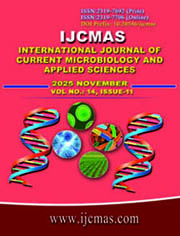


 National Academy of Agricultural Sciences (NAAS)
National Academy of Agricultural Sciences (NAAS)

|
PRINT ISSN : 2319-7692
Online ISSN : 2319-7706 Issues : 12 per year Publisher : Excellent Publishers Email : editorijcmas@gmail.com / submit@ijcmas.com Editor-in-chief: Dr.M.Prakash Index Copernicus ICV 2018: 95.39 NAAS RATING 2020: 5.38 |
Combined effects of different doses of DAP mineral fertilizer (18% N and 46%P) and watering frequency on the initial growth of Moringa oleifera Lam. in the commune of Diffa. Moringa oleifera is a leafy vegetable which cultivation and consumption are of increasing interest to the Nigerien population. This study, conducted in the region of Diffa, aims at studying the combined effects of different doses of mineral fertilizer DAP (18% N and 46%P) and watering frequency on the initial growth of M. oleifera. To do this, a total experimental randomization was set up. Two factors were studied, the fertilizer dose factor (A) and the watering frequency factor (B) with four (4) and three (3) levels respectively. In contrast, treatment A4B1, where M. oleifera plants received no dose of DAP mineral fertilizer and were watered twice (2) a day, had the lowest yield of leaf biomass. The ACP revealed that the A1B1 and A1B2 and, to a lesser extent, A1B3 treatments are characterized by long and wide leaves, a good yield of fresh biomass and dry matter and secondarily by a long main stem, while the A2B2 and A2B1 treatments are characterized by a very good diameter of the main stem, poor yield of fresh biomass and dry matter and shorter roots with a small diameter. The HCA suggested seven (7) groups. At the end of this study, it is advisable to propose to the producers to use three (3) pinches of DAP fertilizer and to water the plants two (2) times a day for a better production of leaf biomass of the species.
Agroconsult H. (2016). Analyse des Potentialités de l’Exploitation du Moringa en Haïti. Ministère de l’Agriculture, des Ressources Naturelles et du Développement Rural (MARNDR), Banque de la République d’Haïti (BRH), Rezo Moringa Dolivayiti, Haïti, 187 p.
Alhado, A. I. (2014). Analyse fonctionnelle des systèmes agroforestiers à base de Moringa oleifera. Lam ; vertus et rôles socioéconomiques du Moringa : cas du site maraicher de Jirataoua. Mémoire de master, Université DAN DICKO Dankoulodo de Maradi. 40 p.
Amaglo, N.K., Timpo, G.M.,Ellis W.O and Bennett,R.N. (2006). Effet de l’écartement et la fréquence des récoltes sur la croissance et le rendement en feuilles de Moringa oleifera Lam. Moringa et autres végétaux à fort potentiel nutritionnel : Stratégies, normes et marchés pour un meilleur impact sur la nutrition en Afrique. Accra, Ghana, 16-18novembre 2006. 11p
Broin, M. (2010). Diagnostc préalable à la sensibisation. CTAACPUE. http://www.moringanews.org
Bonkoungou, E. G., (2001). Production et commercialisation des feuilles de Moringa en Afrique Occidentale étude de cas au Niger. In Potentiel de développement des produits du Moringa 29 octobre - 2 novembre 2001, Dar es Salaam, Tanzanie.
CNRA (2022). Banque alimentaire à base de Moringa oleifera Lam. Par semis direct. Recueil de fiches techniques. 3 p
Foidl, N., Makkar, H. S. et Becker, K., (2001). Potentiel de Moringa oleifera en agriculture et dans l’industrie. Actes du séminaire sur Moringa oleifera du 29 octobre au 2 novembre 2001, Dar es Salaam, Tanzanie. 57p.
Fuglie, L.J. and Sreeja K.V., (2001). Cultivation of Moringa oleifera In: Fuglie, L. J. (ed.). The miracle tree, the multiple attributes of Moringa. Pp. 153-158.
Gamatié, M. (2006). Feuilles de Moringa et autres végétaux à forts potentiel nutritionnel: stratégies, normes et marchés pour un meilleur impact sur la nutrition en Afrique. Atelier international Accra, Ghana. 10p
Ibrahim, S. S., Mahaman, M. A., Abdourahmane T. D. B. and Zaleyha, A. B. (2021). Evaluation de la production du Moringa oleifera Lam. sur substrat constitué de boue de vidange en fonction de la fertilisation et de la dose d’irrigation. Int. J. Biol. Chem. Sci. 15(6): 2417-2425. DOI : https://dx.doi.org/10.4314/ijbcs.v15i6.14
Laurence, R. (2017). Valorisation des légumes Feuilles et introduction de Moringa oleifera chez les maraîchers de Toliara. Mémoire de diplôme d’études approfondies (DEA) en Biodiversité et Environnement, Option Biologie végétale, Université de Toliara, Madagascar, 63 p.
Makkar, R.H.P.S. and Becker K. (1996). Nutritional value and anti-nutritional components of whole and ethanol extracted Moinga oleifera leaves. Animal Feed Science technology. 63, 211-228.
Malo, T. (2014). Effet de la fertilisation sur la croissance et la production de Moringa oleifera local et Moringa oleifera PKM-l dans la Région des Cascades. Mémoire de fin de cycle pour l’obtention du diplôme de Master en productions végétales. Université Polytechnique de Bobo Dioulasso, Burkina Faso, 68 p.
Mawouma, S. and Mbofung, C.M. (2014). Usages alimentaires de Moringa oleifera dans la région de l’Extrême-Nord Cameroun. J. Biol. Chem. Sci. 8(4): 1847-1852.
Moringanews/Moringa Association of Ghana. 2010. Growing and processing moringa pp 17-19
Njehoya, C.A, Sali B., Ko Awono, P.M.D, Hamadou B. (2014). Évaluation du potentiel de germination de Moringa oleifera dans la zone soudano-guinéenne du Cameroun. J. Appl. Biosci. 74:6141– 6148
Rabo, Y. (2019). Structures, fonctionnement et perspectives d’amélioration des Systèmes Agroforestiers à base de Moringa oleifera Lam. dans les vallées du Fleuve Niger et du Goulbi de Maradi au Niger. Thèse de doctorat, Université Dan Dicko Dankoulodo de Maradi, Niger, 152 p
Phatu, W.M. (2019). Responses of Moringa oleifera root growth to container size during overwintering in temperate regions. African Journal of Agricultural Research, 14(2): 65-68. DOI: 10.5897/AJAR2016.11667
Yansoumba B. 2002. Possibilités d’utilisation des eaux usées dans la production forestière : cas de Leptadenia hastata et de Moringa oleifera. Mémoire de fin d’études, ITA, Faculté d’Agronomie de l’Université Abdou Moumouni de Niamey, Niger, 37 p |
 |
 |
 |
 |